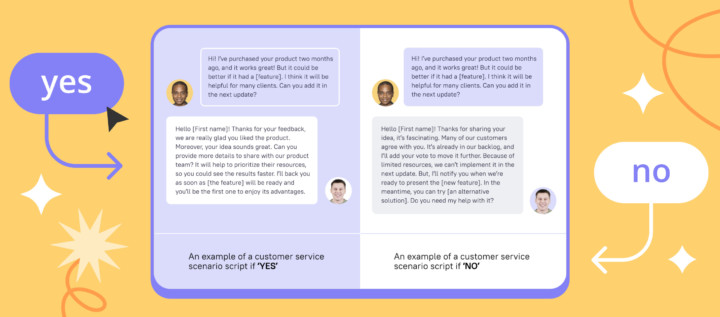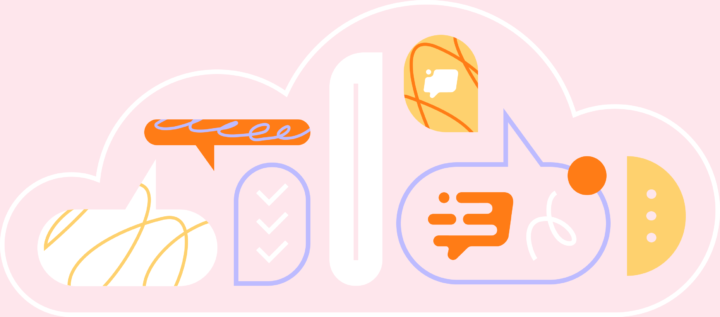How to create a b2b sales funnel: 6 Stages + Examples
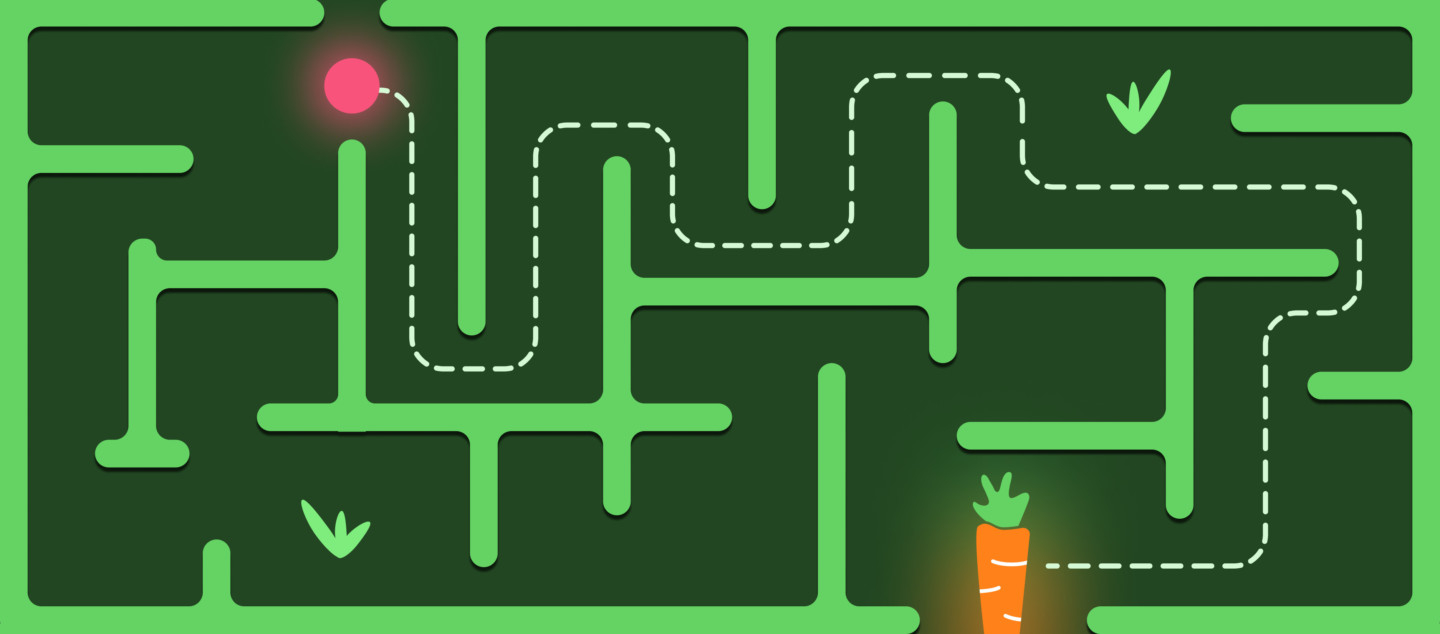
So, you’ve got a B2B product. It’s good. But… where are the sales? That’s where a B2B sales funnel comes in. Think of it like this: a funnel takes all that interest and excitement people have about your product and narrows it down into something actionable. Like meetings. Like SQLs. Sales.
But here’s the catch. Without a solid sales funnel for B2B, you’re losing leads. They vanish somewhere between “Hey, this looks cool” and actually signing up for a demo.
Frustrating, right?
At Dashly.io, we’ve seen it all. B2B sales startups are going through the same pain. But with the right funnel? Boom. Numbers double. More meetings. More deals. And that’s what we do — we help you optimise that process.
You don’t build funnels. You fix the one you already have. And that’s how you grow your B2B sales.
Here we’ve got a detailed guide that shows you exactly how to build the perfect B2B sales funnel step by step 👇
What is a B2B sales funnel?
It’s the path your potential customers take from “Hmm, interesting” to “Let’s do this!” It’s like a map that shows you how your leads move through your B2B sales process.
Who needs it? Every B2B company. Whether you’re selling software or services, a sales funnel for service business is a must. It’s even more important if your customers take a while to make decisions. And yeah, that happens a lot in B2B.
Now, what should it look like?
Usually it looks liek this:

The structure depends on your model sign-up or demo, or mixed, but in terms of the elements B2B sales funnel must have:
- Goals & Metrics
- Channels
- Tools
- Content
The details? I’ll explain them in the How-to part.
What is a B2B sales funnel?
Every B2B funnel has its own specifics. A B2B SaaS funnel? Totally different from a B2B eCommerce funnel or a custom solution funnel. Each one needs its own set of tools to cover all the key stages. But here’s the thing no matter the funnel type, they all follow the same basic flow, taking customers through the mental and practical steps of their journey.
The basic B2B customer journey is made up of 6 stages:
Awareness
At this stage, your potential customers start to realize they have a problem or a need. Sometimes, it happens naturally. Other times, it’s because of your clever marketing campaigns across different platforms.
They might also stumble upon your brand while researching something related to their pain points that’s when they enter the awareness stage. To grab their attention, focus on content marketing and SEO.
If you’ve set up your content marketing strategy, now’s the time to set up your acquisition engines. Think PPC, SEO, social media, inbound marketing whatever fits your approach.
Don’t have the expertise? No worries. You can always bring someone on board, or even hire an SEO agency to handle it for you.
B2B sales funnel examples for the awareness stage:
- Informational blog posts
- PPC landing pages
- Social media posts
- Youtube videos
- Quora or Reddit answers
- Podcasts
Once they’re aware of their need, they’ll likely move on to the next stage, where they’ll hunt for reliable sources to dive deeper into what your business and products are all about.
Interest
As prospects enter the Interest stage, they start digging into resources to understand how to solve their problem. This is when they first hear about your solution, not necessarily your specific products or services yet.
At this point, they’re not just comparing you to your competitors; they’re trying to answer those big “who should I choose?” and “why should I care?” questions about their need.
This stage marks the shift from Pain Aware to Solution Aware, and eventually to Product Aware where they’ll finally get to know your product or service.
As they learn about you, they’ll likely come across your competitors too. And that’s when the evaluation phase begins, where prospects start weighing whether your offer is the right fit for them.
B2B sales funnel examples for the Interest stage:
- Product centric blog posts
- Product pages
- FAQs
- White papers
- Webinars
- Conventions
- Guest posting
Evaluation
The evaluation stage is where you show prospects that your solution is the perfect match for their needs.
Your main goal here? Building a real relationship with your leads to understand their ultimate goals. To do this, you’ll need to offer the right content to ease their worries, build trust, boost your credibility, and clearly highlight how your value stands out from the competition.
It’s also crucial to nail your Voice of Customer (VoC) copy on landing pages, create a consistent brand voice, and fine-tune your Unique Value Proposition (UVP). Everything should speak directly to your target audience’s needs and desires.
B2B sales funnel examples for the Evaluation stage:
- Pricing page
- Case studies
- Whitepapers
- Product documentation
- Product features page
- Product comparison tables
- Featured product reviews on known industry websites
- Thought leadership articles
- Video testimonials
- Customized solutions
- Client Brand logos
- Customer Reviews
- Trust badges (G2, Capterra, Trust Pilot, etc.)
- Awards
- Security and compliance credentials and certificates
- Privacy policy
- Proper CTAs
Once you’ve convinced prospects to give your product a shot, they move to the next key step — Engagement.
Engagement
In the Engagement stage, your leads start interacting with your sales team. First up? Qualifying those leads based on where they stand in the buyer’s pyramid (not to be confused with the buyer’s journey). Typically, this is handled by an SDR.
This step is crucial. If your sales team spends time on a prospect who’s not likely to convert, it can drain valuable resources.
Once the lead is qualified, the focus shifts to building a real connection. It’s not just about showcasing your product it’s about creating trust and even a sense of friendliness between the buyer and your salesperson.
At this stage, you want to show how your solution directly addresses their needs, explain how the implementation works, and outline what comes next. Make it clear that you understand their pain points and offer tailored solutions to solve them.
B2B funnel examples for the Engagement stage (assets and actions):
- A product tour or walkthrough
- A live demo
- Educational presentations
- Email signature marketing campaign
- Newsletter
- Onboarding
- Technical support
- Special discounts
Purchase
The purchase stage is pretty simple. It’s the result of months of hard work. When the prospect buys, they become your client. Well done! Now it’s time to deliver on what you promised.
B2B sales funnel examples for the Purchase stage:
- Contact page
- Telephone number
- Subscription form
- Saved items page
- Cart
- Cart abandonment automated email
- Payment page
- Thank you page
But here’s the thing it doesn’t end there. If you truly deliver value, you’ll likely add a new stage to your funnel: Loyalty.
Loyalty
The loyalty stage is the heartbeat of your funnel. Post-purchase engagement is key to building a strong B2B sales pipeline. Why? Because keeping your clients happy is what makes them stick around. And happy clients? They’ll put up with a few hiccups way more than dissatisfied ones who feel ignored.
HubSpot points out that just a 5% boost in customer retention can increase revenue by 25-95% and that’s how you grow your customer’s Lifetime Value (LTV).
Plus, excited customers are more likely to become your brand advocates, leaving glowing reviews and sharing testimonials. Build enough of them, and you’ll create a buzz that positions your brand as the go-to choice in your niche.
B2B sales funnel examples for the Loyalty stage:
- Product onboarding (for SaaS B2B funnels)
- Email marketing nurture campaign
- B2B Email marketing
- Upsell proposals (email automation)
- Customer success calls
- Branded email signature
- CSAT emails
- Product engagement tracking
- User interviews
- Events and webinars
- Product update
Is there a difference between B2B sales and marketing funnel?
A sales funnel for B2B and a B2B marketing funnel might sound similar, but they serve different purposes.
The B2B marketing funnel is all about creating awareness and generating interest. It’s the top of the funnel. Your marketing team works to grab attention through channels like ads, social media, blog posts, and email campaigns.
The goal? Drive potential leads to your website or landing pages. You’re not closing deals here —you’re just starting the conversation.
On the other hand, the B2B sales funnel is where things get serious. This is where your sales team steps in.
After marketing has done its job, the sales team takes over, qualifying leads, nurturing them, and guiding them toward a deal. It’s about building relationships, solving problems, and, ultimately, closing the sale.
So, if the B2B marketing sales funnel is the roadmap, the sales funnel is the pit stop where decisions get made.
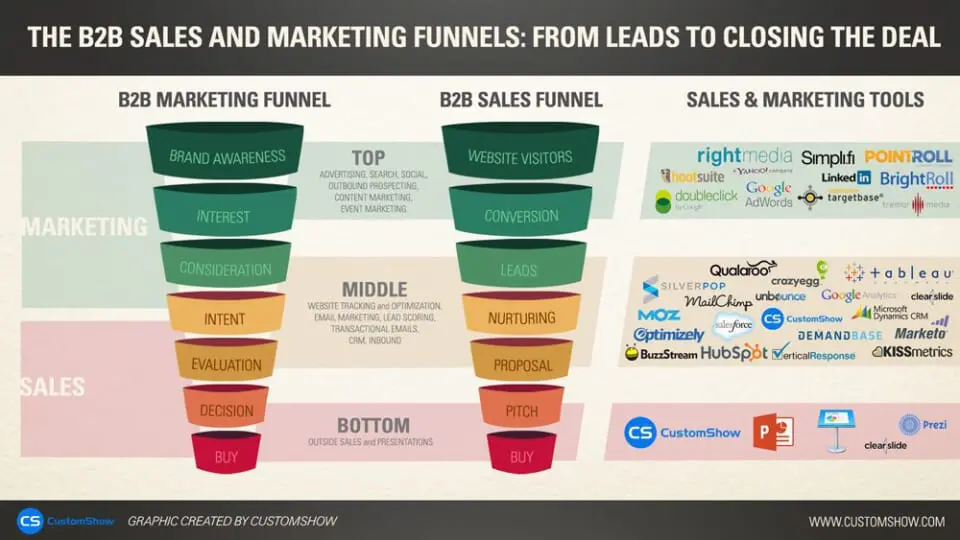
In short: Marketing generates interest, sales closes the deal. Both funnels are crucial for growing your B2B business, but they tackle different parts of the customer journey.
B2B vs B2C sales funnel
Alright, let’s break down the difference between a B2B sales funnel and a B2C sales funnel in a way that’s easy to follow.
The B2B sales funnel and the B2C sales funnel are designed for different audiences. In B2B, you’re selling to businesses — multiple decision-makers, longer sales cycles, and more personalized communication. In B2C, it’s all about selling directly to the consumer—faster sales cycles, emotional buying decisions, and higher volume.
In B2B, sales take longer because there are more hoops to jump through — approvals, meetings, budgets. The B2B sales funnel is all about building relationships and trust over time. It’s more complex. On the flip side, a B2C sales funnel moves fast. It’s emotional. It’s about triggering impulse purchases and providing quick value.
Here’s a table to make it clearer:
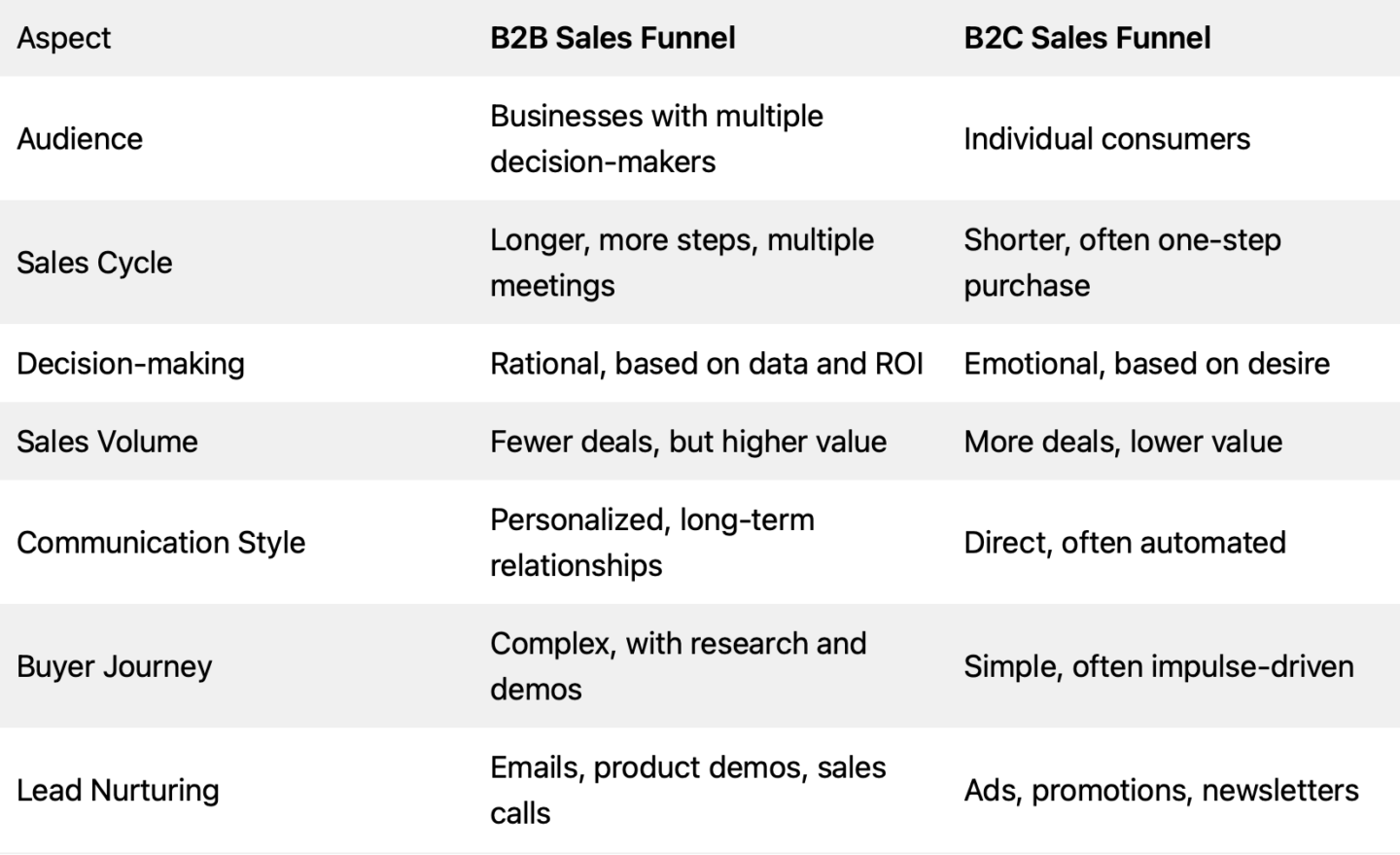
In sales funnel B2B, every step is about nurturing a relationship and solving a specific business problem. You’re dealing with a higher price point, so it takes time. In B2C, you’re focused on quick wins—getting the customer to make a decision fast.
So, if you’re a SaaS company CEO, your B2B sales funnel should reflect those longer cycles and decision-makers. Make sure you’re personalizing and nurturing, not rushing the process.
B2B sales funnel stages that a B2C funnel does not have
Let’s talk about what makes a B2B sales funnel unique. While both B2B and B2C funnels focus on getting leads to convert, there are a few extra stages in a B2B sales funnel that you won’t typically see in B2C. These stages help manage the longer, more complex decision-making process in B2B sales.
Here are some key stages that B2C funnels don’t have:
- Lead Qualification. In B2B, not every lead is worth pursuing. You need to make sure they’re the right fit, so this stage filters out unqualified leads.
- Multiple Decision-Makers. B2C typically deals with one buyer. In B2B, you have to get buy-in from several people, often in different departments.
- Product Demos. Unlike B2C, where a quick purchase is common, B2B deals usually require a product demo or trial to convince leads.
- Negotiation & Contracting. Pricing, terms, and conditions often need to be negotiated in B2B sales, which adds a whole new layer to the funnel.
These stages are essential to a strong B2B marketing funnel and help ensure that the right leads become long-term customers.
Why are B2B sales cycles longer than those of B2C?
Simple. In B2B, you’re not just selling to one person. You’re dealing with multiple decision-makers, approval processes, and budget checks. That takes time.
In a B2B sales funnel, there’s more at stake. Buyers need to evaluate how your product or service impacts their entire business. Plus, they often need product demos, custom proposals, and contracts. It’s not an impulse buy. For a sales funnel for service business, this process can stretch out even further because services often require tailored solutions.
In short, B2B sales involve bigger investments, more complexity, and, naturally, a longer decision-making process.
Read also: Build Your Funnel The 15 Best Sales Funnel Builder Software Options
Why Does My B2B Business Need a Sales Funnel?
Why does your B2B business need a sales funnel? Let’s keep it simple. A B2B sales funnel helps you track, nurture, and convert leads into paying customers. Without it, you’re just guessing. And in B2B sales, you can’t afford to guess. Here’s why having a sales funnel B2B is crucial for your growth, with examples from our work at Dashly.
- Better Lead Qualification
Not every lead is worth your time. A B2B sales funnel lets you filter out unqualified leads early on, so your sales team spends time on prospects who are actually a fit. We worked with a SaaS client who was overwhelmed with unqualified leads. By implementing lead scoring in their funnel, they focused only on high-quality prospects and saw a 40% increase in demo-to-close rates. - Improved Lead Nurturing
In B2B, leads take longer to convert. They need to be nurtured with personalized content and communication. A funnel keeps that process organized. One of our clients, a mid-sized SaaS company, used automated email sequences to nurture leads based on where they were in the funnel. This approach doubled their meeting bookings in just three months. - Clear Visibility of the Sales Process
A B2B marketing funnel gives you a bird’s-eye view of where your leads are in the buying journey. We helped a startup that had trouble tracking leads across stages. With a structured funnel, they identified where prospects were getting stuck and increased their conversion rate by 25%. - Shorter Sales Cycles
A well-optimized B2B sales funnel can actually shorten your sales cycle. One Dashly client reduced their sales cycle by 30% after we optimized their funnel. We identified bottlenecks, streamlined follow-ups, and automated parts of the process to speed things up. - Consistent Revenue Growth
Without a sales funnel, your revenue is unpredictable. With one, you have a clear path to generating consistent revenue. A service business we worked with went from sporadic sales to consistent month-over-month growth by refining their funnel and focusing on nurturing qualified leads.
A B2B business without a funnel is like a car without a GPS. You might get there, but it’ll take longer, and you’ll probably make a lot of wrong turns.
B2B sales funnel stages
Let’s dive into the B2B sales funnel stages — the key steps your leads go through on their journey to becoming paying customers.
Here is how it may look like:
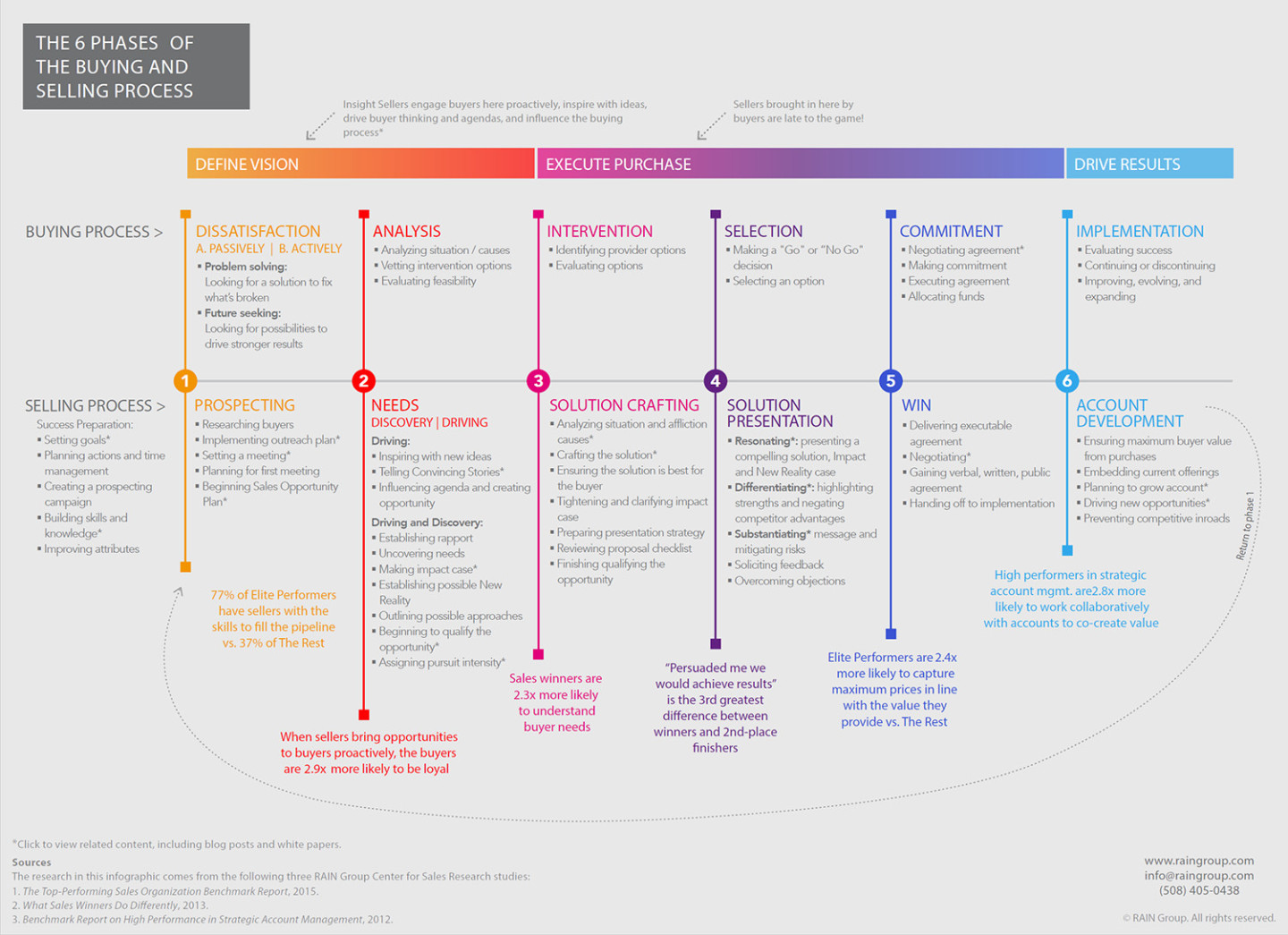
Here’s the breakdown, step by step.
1. Lead Generation
At the very top of the B2B sales funnel, it’s all about getting attention. You’re casting the widest net to attract leads through things like content marketing, social media, paid ads, and SEO. This is where your B2B marketing funnel stages start to do the heavy lifting. The goal? Bring in as many qualified leads as possible who are genuinely interested in what you offer.
2. Lead Qualification
Once you’ve got leads, it’s time to qualify them. Not everyone who enters the sales funnel B2B is ready to buy. In fact, most aren’t. This stage helps you filter out the ones who aren’t a good fit or aren’t ready yet. A solid qualification process saves your B2B sales team from wasting time on dead-end leads.
3. Lead Nurturing
Here’s where things get personal. The B2B sales funnel stages shift to nurturing. You know those leads that are interested but not quite ready to buy? This stage is for them. You’ll use email campaigns, webinars, and personalized content to keep them engaged. It’s all about building trust and helping them see the value in what you offer.
4. Product Demos and Presentations
At this stage, your leads are interested enough to want to see your product in action. For many B2B sales teams, this is the turning point. Demos, personalized presentations, or consultations are common here. The sales funnel stages B2Bfocus heavily on showing the solution to your lead’s problem, which is key in B2B.
5. Negotiation and Objection Handling
This is where things can get tricky. In the B2B sales funnel, you’ll often face objections, pricing concerns, or specific contract negotiations. Your job here is to address those issues while showing the long-term value of your solution. The longer B2B sales cycle really becomes obvious at this point, as multiple decision-makers may weigh in.
6. Closing the Deal
Finally, we’re at the finish line. The lead is ready to become a customer. All that’s left is closing the deal. For sales funnel B2B, this usually means finalizing contracts, getting signatures, and making sure both sides are aligned. It might take a bit of back and forth, but with a well-structured funnel, you should close with confidence.
So, there you have it. The B2B sales funnel takes leads from awareness to close through a series of important stages. Understanding these sales funnel stages B2B is key to building a successful sales funnel that helps your company grow. Whether you’re in SaaS or services, a clear understanding of your B2B marketing funnel stages will set you up for long-term success.
B2B sales funnel examples for every stage of the pipeline
Let me share some insights based on my experience working with various B2B startups and mid-sized SaaS companies, plus examples from some of the biggest players in the industry.
A well-structured B2B sales funnel can truly make the difference between chasing leads and consistently closing deals. Here’s how each stage plays out, with B2B sales funnel examples you can relate to.
1. Lead Generation: Start the Conversation
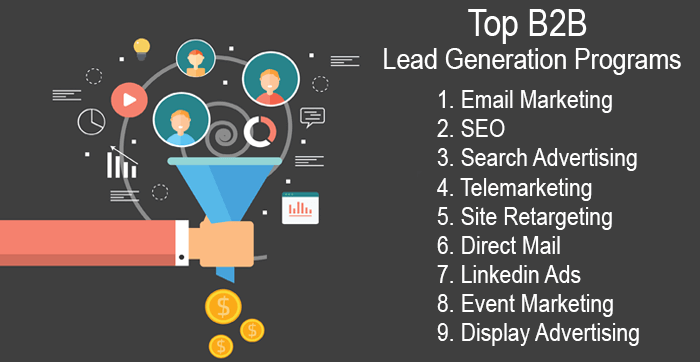
At the very top of your B2B sales funnel, it’s all about grabbing attention.
How? Think content marketing, social media ads, and webinars. For example, HubSpot has mastered lead generation with their free CRM trials and educational content. They use blog posts, guides, and eBooks to gather leads, pulling prospects into the funnel.
The goal? Get interested leads to hand over their contact info and get them into your sales funnel B2B.
2. Lead Qualification: Sorting the Good from the Meh
Once you’ve got those leads, you need to qualify them. Not all of them are going to be ready — or even a good fit.
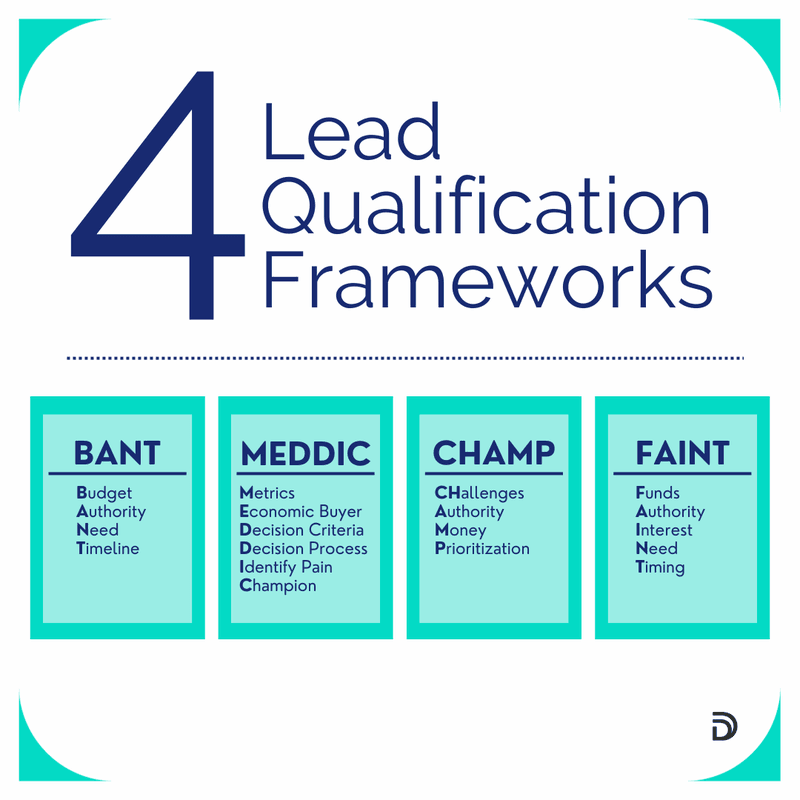
One client used a quick quiz to filter out low-quality leads. Another great example comes from Salesforce. They use lead scoring to rank prospects based on their engagement level and readiness to buy.
This helps their B2B sales team focus on high-potential leads, making their funnel much more efficient.
3. Lead Nurturing: Building the Relationship
Now it’s time to nurture those leads who aren’t quite ready to buy.
Let’s take Marketo as an example. They use sophisticated email nurturing campaigns to send personalized content over time. Whether it’s case studies or webinars, they provide value and slowly build trust.
In your B2B sales funnel, this stage keeps your leads warm and engaged until they’re ready to move forward.
4. Product Demos: The Big Show
When leads are ready, it’s demo time. Take a note from the playbook of companies like Zoom. They offer live product demos to showcase features and help customers see the real value. In the sales funnel, this is a critical step where you prove your product can solve the customer’s problem.
A great demo can be the turning point in moving leads closer to a decision.
5. Negotiation: Overcoming Objections
Here’s where things can get a bit tricky. Your lead may have concerns — whether it’s pricing or contract terms. One famous example is IBM, which often addresses these by offering tailored solutions and flexible terms to close deals.
In your sales funnel B2B, being ready to negotiate and handle objections is key to pushing through this stage.
6. Closing the Deal: Let’s Do This
Finally, closing. We’ve all heard about how fast DocuSign closes deals thanks to their own product, which streamlines contract signing. Automating this final step reduces friction and speeds up the process, which is crucial in any B2B sales scenario. A seamless close is what brings your B2B sales funnel to a successful end.
The key takeaway?
Whether you’re using sophisticated email nurturing or live demos, it’s all about moving leads from awareness to decision with a well-structured sales funnel. With the right steps, your funnel will drive real growth.
Read also:
7-Step Blueprint for Success with the Inverted Sales Funnel
The Ultimate Guide to Sales Funnel Conversions: Top Stats and Tips for 2024
How to Create a Leak-Proof Funnel for B2B Sales?
You’ve got a product. It’s solid. But where are the B2B sales? Leads are slipping away, and that’s where a leak-proof sales funnel comes in. Picture it: instead of losing prospects at every stage, you catch them all and guide them to the finish line.
Sounds ideal, right? Here’s how you can create a leak-proof B2B sales funnel that works.
1. Know Your Ideal Customer Inside Out
First things first, you can’t build a funnel without knowing who you’re trying to catch. Who is your ideal B2Bcustomer? Not just any lead, but the ones who are ready and willing to buy.
Dig deep. What are their pain points? What solutions are they looking for? And most importantly, where do they hang out online?
The better you know your ideal customer, the tighter your sales funnel B2B will be. This ensures you’re bringing in the right people from the start and not wasting time on bad-fit leads.
2. Streamline Your Lead Generation
Okay, now that you know your target, let’s talk about lead generation. Your sales funnel begins here. Think of this as the top of your funnel, where prospects are just starting to engage with you.
Keep it simple. Offer something valuable — like a guide, webinar, or product demo — that your ideal customer can’t resist. But make sure there’s a clear and easy way for them to take action, whether it’s signing up, downloading, or booking a demo. A cluttered lead gen process is a leaky funnel’s best friend. Keep it clean, smooth, and easy to follow.
3. Tighten Your Qualification Process
This is where a lot of leaks happen. You’ve generated leads, but now what? Not all leads are created equal, and some just aren’t worth pursuing (yet).
Tighten up your qualification process by adding a filter. Whether it’s asking specific questions in your contact form or using lead scoring, you need to figure out which leads are hot and which ones need more nurturing. A smart qualification system means your B2B sales team focuses on leads that are ready to move down the funnel.
Remember: not all leads should go to sales right away. Some need a bit more time in the oven.
4. Nurture Leads Until They’re Ready
Now, here’s where the magic happens. You’ve got leads that aren’t ready to buy yet. That’s fine. You just need to nurture them until they are. This is the mid-funnel stage.
Keep your sales funnel B2B flowing by providing helpful content, personalized emails, and targeted follow-ups. Show them that your product is the solution to their problem. It’s like dating—build the relationship first, then pop the question. The more personalized and value-driven your nurturing is, the fewer leads will fall through the cracks.
5. Don’t Let Them Escape at the Close
You’ve done all the hard work — now don’t lose them at the finish line. Closing is where the real leaks can happen, but it’s also where you need to be airtight. Your B2B sales process should be seamless, especially when you’re finalizing deals.
Make it easy to say “yes.” Offer clear pricing, flexible terms, and quick follow-up. Use tools like e-signatures to eliminate unnecessary back-and-forth. And don’t forget to address any last-minute objections — they’re often the reason leads vanish right before signing the deal.
There you have it — a leak-proof B2B sales funnel in five steps. Each stage builds on the other, from knowing your customer to closing the deal. And trust me, once you’ve tightened these areas, you’ll see the results: fewer lost leads, more meetings, and more sales.
Top 8 typical mistakes
These are the ones we’ve seen trip up even the best teams, but don’t worry—each one has a fix. Here’s how you can avoid them and get your B2B sales flowing smoothly.
1. Not Defining Your Ideal Customer
Big mistake.
If you don’t know who your ideal customer is, your sales funnel B2B is going to be full of holes. You’ll waste time chasing leads that will never convert.
Fix: Define your customer persona. Get specific. Who are they? What are their pain points? What solutions are they searching for? The more focused you are, the less time you’ll waste.
2. Skipping Lead Qualification
Here’s the deal: not every lead is ready to buy. If you skip qualification, your B2B sales team will waste time on leads that go nowhere.
Fix: Add a lead scoring or qualification step. Use forms or even a simple quiz to filter out leads that aren’t a good fit right now. Focus your sales efforts on high-potential prospects.
3. Overcomplicating the Funnel
Keep it simple.
A complicated sales funnel confuses your prospects and makes them drop off before you can close the deal. Too many steps, too much friction.
Fix: Simplify. Make sure each stage of the sales funnel B2B has a clear and easy next step. Don’t overwhelm your prospects with too much information upfront.
4. Not Nurturing Leads
Most leads won’t buy right away. If you aren’t nurturing them, you’re missing out on future deals. This is a classic funnel mistake.
Fix: Set up automated nurturing campaigns. Use personalized emails, case studies, and product demos to keep your leads engaged. Show them why your product is the best solution for their problem.
5. Ignoring Data and Metrics
Flying blind is a recipe for leaks. If you aren’t tracking data in your B2B sales funnel, you won’t know what’s working or where leads are dropping off.
Fix: Use a CRM or analytics tool to track every step of your funnel. Where are leads getting stuck? Adjust based on what the data tells you. Track everything, from email open rates to deal closures.
6. Taking Too Long to Follow Up
Leads are hot when they first show interest. If your follow-up takes too long, you’re going to lose them. Timing matters.
Fix: Automate your follow-ups. The moment a lead engages with your content, make sure they get an immediate response. Quick, personalized follow-ups can make all the difference.
7. Not Addressing Objections Early
Objections happen. Pricing, product fit, timing—these things come up. But if you wait until the last minute to address them, you’ll lose deals.
Fix: Proactively handle objections in your content and conversations. Anticipate the common concerns and offer solutions. Addressing these early builds trust and keeps leads moving through the funnel.
8. Neglecting the Close
You’ve done the hard work. But then… you don’t push for the close. Leads slip through your fingers because you didn’t make it easy to say “yes.”
Fix: Make closing seamless. Use tools like e-signatures to speed up the process. Be clear and confident when asking for the sale. Sometimes, all it takes is a simple nudge to close the deal.
These mistakes might seem small, but they can seriously hurt your B2B sales funnel. Luckily, with a few tweaks, you can plug those leaks and start closing more deals. Sound familiar? It’s easy to fix with the right approach.
Conclusion
Building a strong B2B sales and marketing funnel comes down to avoiding these common mistakes. Whether it’s qualifying leads, nurturing them properly, or streamlining your process, these tweaks will help you close more B2B salesand boost your overall performance.
Remember, a well-structured sales funnel keeps your leads engaged and moving toward that final “yes.” Fix those leaks, and watch your B2B sales grow!
FAQ
A B2B sales funnel is the process that guides potential business clients from the awareness stage to becoming paying customers. It’s all about narrowing down leads through a series of sales stages, helping your B2B team focus on qualified prospects and increase conversions. The sales funnel breaks down the customer journey into clear steps, making it easier to track and optimize.
The 5 stages of a B2B sales funnel are:
Awareness — When potential customers first discover your B2B product or service.
Interest — Prospects engage by learning more through content or demos.
Consideration — Leads evaluate your offer against competitors.
Decision — Prospects decide whether to purchase your sales solution.
Action — The final step, where the deal is closed and the customer makes the purchase.
A typical B2B funnel includes several key stages: attracting leads, qualifying them, nurturing, and then closing the deal. It focuses on building long-term relationships because B2B sales cycles tend to be longer and involve multiple decision-makers. The B2B sales funnel process often includes personalized communication, demos, and negotiation before a purchase is made.
To create a B2B funnel, you need to first define your ideal customer. Then, build out stages for attracting and qualifying leads. You’ll want to nurture these leads with personalized content until they are ready for B2B sales discussions. Finally, guide them toward decision-making and closing the deal. A strong B2B sales funnel streamlines the process, ensuring that you’re focusing on the right prospects at the right time.
A B2B marketing funnel focuses on generating awareness and nurturing leads at the top of the funnel before they reach the B2B sales stage. It includes content marketing, social media, and email campaigns that help move leads through the early stages of discovery and interest, preparing them for engagement with your B2B sales team.
Read also:
– 10 inspiring sales funnel examples to boost your business growth;
– Mastering sales funnel analysis: step-by-step guide, tools, and examples;
– Ultimate guide to an AI sales funnel: the best tips, tools and common mistakes to avoid.


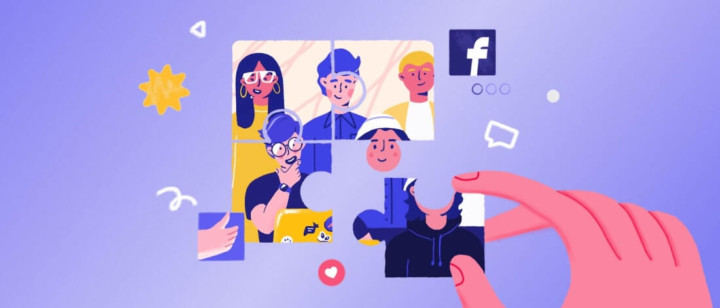
![Top 10 Best Custom Chatbot Platforms for your website [+AI]](https://www.dashly.io/blog/wp-content/uploads/2020/06/cover-1-720x308.jpg)
![4 steps as Chief Marketing Officer at a new company [Expert guide]](https://www.dashly.io/blog/wp-content/uploads/2022/10/4-steps-as-Chief-Marketing-Officer-at-a-new-company-Expert-guide-720x317.jpg)
